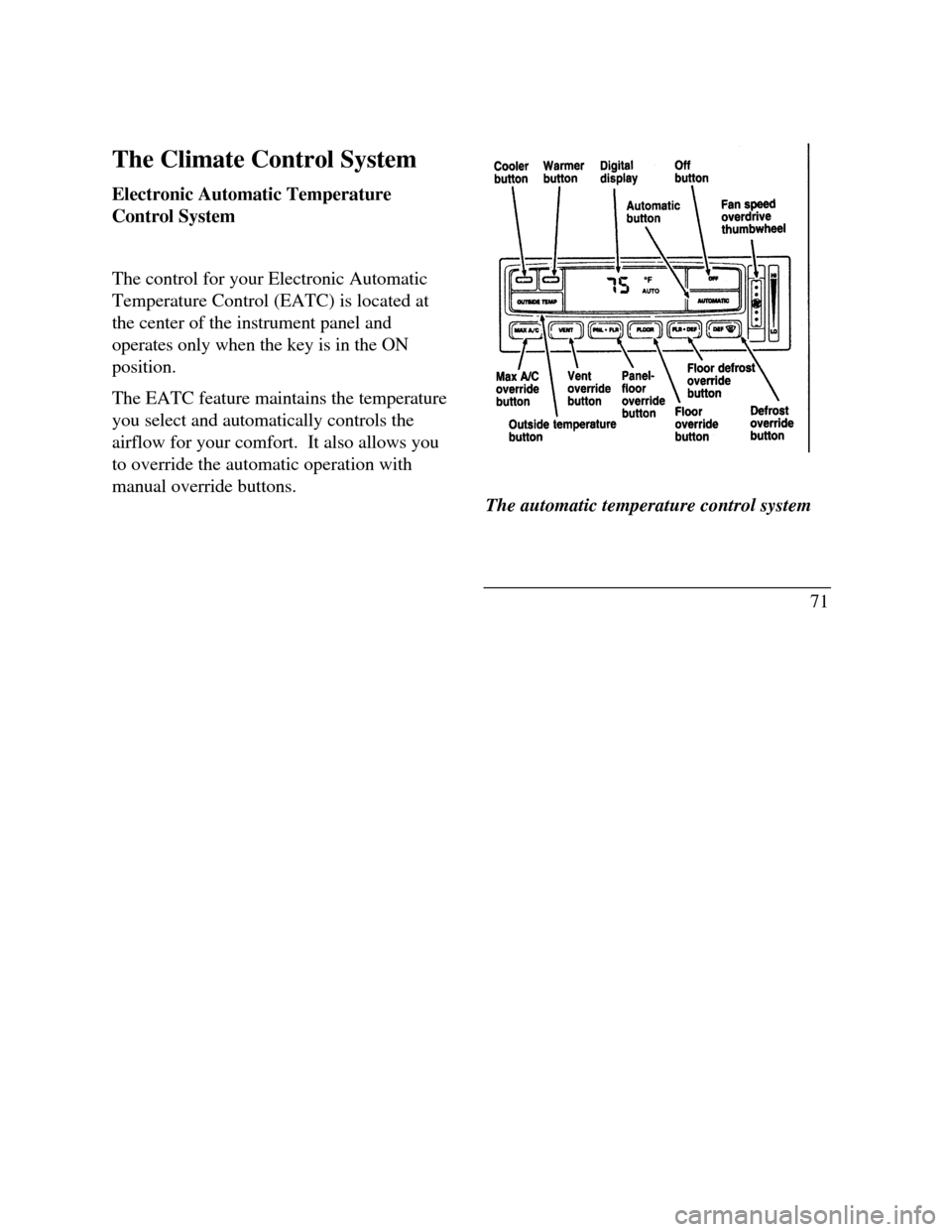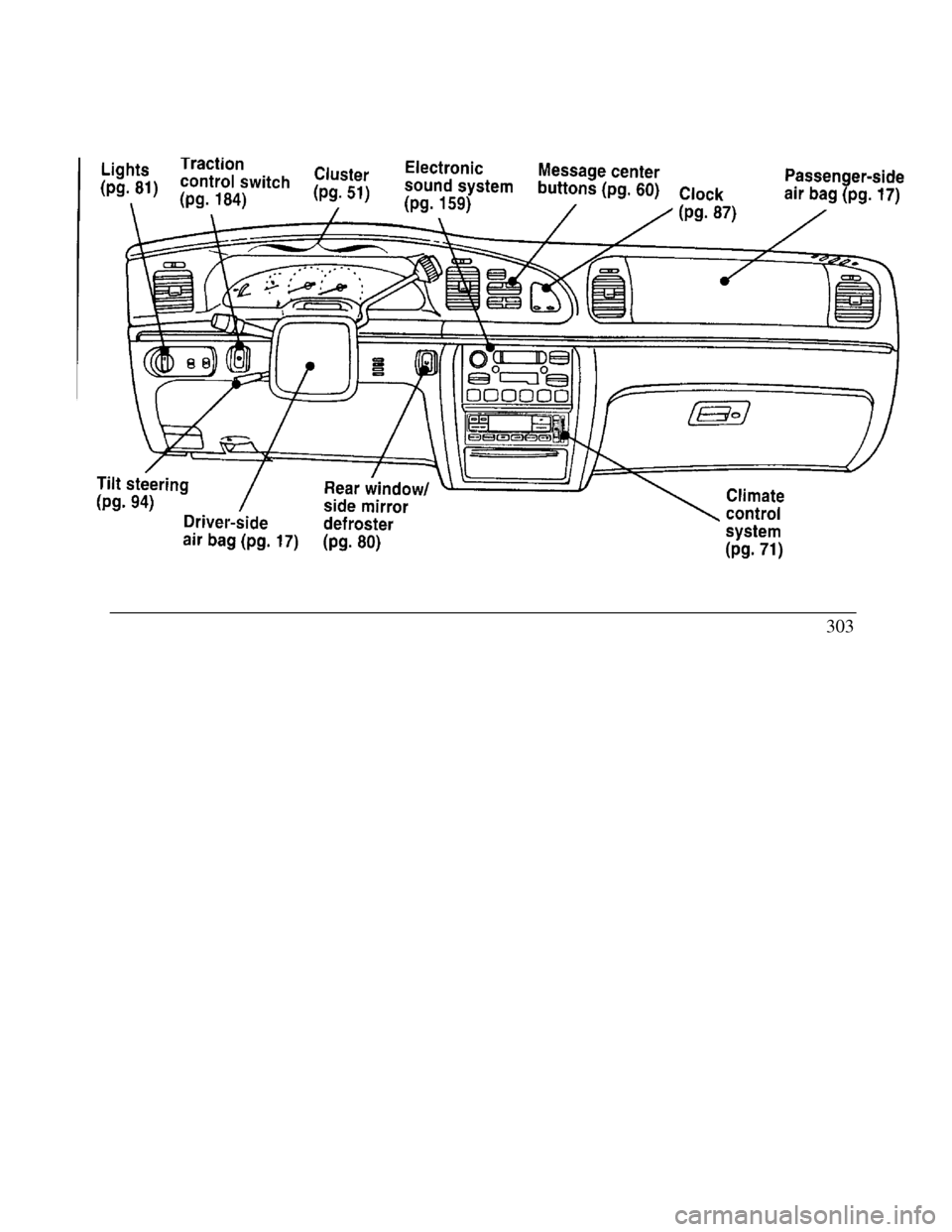1996 LINCOLN CONTINENTAL climate control
[x] Cancel search: climate controlPage 53 of 320

Have the exhaust and body ventilation systems
checked whenever: your vehicle is raised for service the sound of the exhaust system changes your vehicle has been damaged in a collision
Improve your ventilation by keeping all air inlet
vents clear of snow, leaves, and other debris.
50If the engine is idling while you are stopped in an
open area for long periods of time, open the
windows at least one inch (2 . 5 cm). Also,
adjust the heating or air conditioning to bring in
outside air.
If you use the Electronic Automatic Climate
Control, set the fan speed selector dial to a
medium or high blower speed with the VENT or
PNL-FLR function buttons pressed.
Page 66 of 320

Warning messages that have been reset are
divided into two categories. They will
reappear on the display ten minutes from the
reset or they will not reappear until an ignition
OFF-ON cycle has been completed. This
reappearing of warning messages is a reminder
that these warning conditions still exist within
the vehicle.
EIM
A press of this button allows you to change the
M/C and the Electronic Climate control unit
from English to Metric Units. When you press
this button all displays change from English to
Metric or Metric to English units. The
displays remain in the units you have chosen
until you change them again even after you
turn off the vehicle and start it again.
TRIP
Pressing this button will display the first of two
trip odometers. Pressing it again will display
the second Trip Odometer. Pressing RESET
will clear only that Trip odometer which is
displayed.DTE/ECON
Pressing this button a first time will display
approximately how many miles you can drive before
you run out of fuel, or in other words the Distance
To Empty (DTE). To ensure accuracy, turn the
ignition OFF when you fill the tank.
Pressing this button a second time will allow you to
display your Average Fuel Economy in miles/gallon
or Uters/100 kilometers. Your WC computes this
figure using the distance traveled and rate of fuel
used information. If you want to reset this feature,
press the RESET button while the Average Fuel
Economy feature is displayed.
NOTE: DTE (Distance to Empty) is calculated
using a "Running Average Fuel Economy" initialized
by the factory. This value is not the same as the
Average Fuel Economy Display. The Running
Average Economy is based on more than 500 miles
(800 km) of driving history. Also the factory default
for Running Average Economy is reinitialized if the
battery is disconnected.
63
Page 72 of 320

Instrument Panel ControlsThe instrument panel (dashboard) on your
vehicle is divided into several different
sections. The illustrations on the following
pages show the major parts of the
instrument panel that are described in this
chapter. Some items shown may not be on
all vehicles.
The main controls for the climate control system,
clock, and radio are on the instrument panel.If you have radio transmitting equipment in your
vehicle, be aware that it can interfere with your
vehicle's electrical system and may cause the
instrumentation and/or convenience products to
have temporary, abnormal operation.
NOTE: Any cleaner or polish that increases the
gloss (shine) of the upper part of the instrument
panel should be avoided. The dull finish in this
area is to help protect the driver from undesirable
windshield reflection.
Clean the instrument panel lens and woodtone trim
with a soft cloth and a glass cleaner. Do not use
paper towel or any abrasive cleaner to clean either
the lens or the woodtone trim as these may cause
scratches.
69
Page 74 of 320

The Climate Control System
Electronic Automatic Temperature
Control System
The control for your Electronic Automatic
Temperature Control (EATC) is located at
the center of the instrument panel and
operates only when the key is in the ON
position.
The EATC feature maintains the temperature
you select and automatically controls the
airflow for your comfort. It also allows you
to override the automatic operation with
manual override buttons.The automatic temperature control system
71
Page 261 of 320

Treadwear
The treadwear grade is a comparative rating based
on the wear rate of the tire when tested under
controlled conditions on a specified government test
course. For example, a tire graded 150 would wear
one and one-half (1 1/2) times as well on the
government course as a tire graded 100. The
relative performance of tires depends upon the
actual conditions of their use, however, and may
depart significantly from the norm due to variations
in driving habits, service practices and differences in
road characteristics and climate.
Traction A B C
The traction grades, from highest to lowest, are A, B,
and C, and they represent the tire's ability to stop on
wet pavement as measured under controlled
conditions on specified government test surfaces of
asphalt and concrete. A tire marked C may have
poor traction performance. Warning: The traction
grade assigned to this tire is based on braking(straightahead) traction tests and does not include
cornering (turning) traction.
Temperature A B C
The temperature grades are A (the highest), B, and
C, representing the tire's resistance to the generation
of heat and its ability to dissipate heat when tested
under controlled conditions on a specified indoor
laboratory test wheel. Sustained high temperature
can cause the material of the tire to degenerate and
reduce tire life, and excessive temperature can lead
to sudden tire failure. The grade C corresponds to a
level of performance which all passenger car tires
must meet under the Federal Motor Vehicle Safety
Standard No. 109. Grades B and A represent higher
levels of performance on the laboratory test wheel
than the minimum required by law. Warning: The
temperature grade for this tire is established for a tire
that is properly inflated and not overloaded.
Excessive speed, underinflation, or excessive
259
Page 301 of 320

Lights Traction control Tilt steering Driver-side air bag Lights Traction Cluster Electronic sound system Tilt steering Rear window/ side mirror
Driver-side defroster air bag Message center buttons Clock Climate control system Passenger-side air bag303
Page 308 of 320

Cleaning your vehicle (continued)...............Console, description...............................133
instrument panel................................69Controls, mirrors....................................127
mirrors.....................................126,127Coolant (see Engine coolant)........................
plastic parts.........................................8checking and adding...........................247
polishing..............................................7drain and flush....................................251
rustproofing.........................................8preparing for storage..........................291
safety belts.........................................17refill capacities...................................287
tail lamps...........................................83specifications......................................289
upholstery and interior trim..............118temperature gauge................................66
washing...............................................7Cooling fan.............................................233
wheels.............................................260D..................................
Climate control system...............................Dashboard (see Instrument panel).............69
air conditioning..................................71Daytime running light system....................81
electronic automatic temperature...........Defrost, windshield...................................78
control............................................71Dipstick........................................................
heating...............................................71engine oil...........................................246
Clock.....................................................87power steering fluid............................264
Cold engine starting...............................44Dispute Settlement Board.......................214
Compact disc player (see Electronic...........Doors.......................................................99
sound system)....................................169lubricant specifications.......................289
Compass..............................................139................................................................
310
Page 318 of 320

Tune-up specifications (VECI).............285W.......................................
Turn signal.................................................Warm engine, starting...............................45
indicator lights...................................56Warning chimes............................................
lever..................................................89headlamps on.......................................58
.............................................................key in ignition......................................42
u................................safety belt............................................52
Used engine oil, disposal.........232,250,262Warranties, radio....................................178
Universal transmitter....130Warranty Information Booklet....................5
....................................Washer fluid
....................................Vreservoir............................................254
Variable interval wipers91windshield254
VECI (Vehicle Emission Control.................Weight limits (GAWR, GVVVR).........192
Information) decal................................286Wheels
Vehicle loading............................................anti-theft lugnuts.............................209
automatic transaxles...........................193cleaning...........................................260
calculating the load.............................193inspection and maintenance..............255
Vehicle storage.......................................290Windows..............................................111
Ventilating your vehicle...............................power windows, operating...............111
(see Climate control)..............................77
Viscosity (see Engine oil)........................245
Visor (see Sun visor)...............................128
320